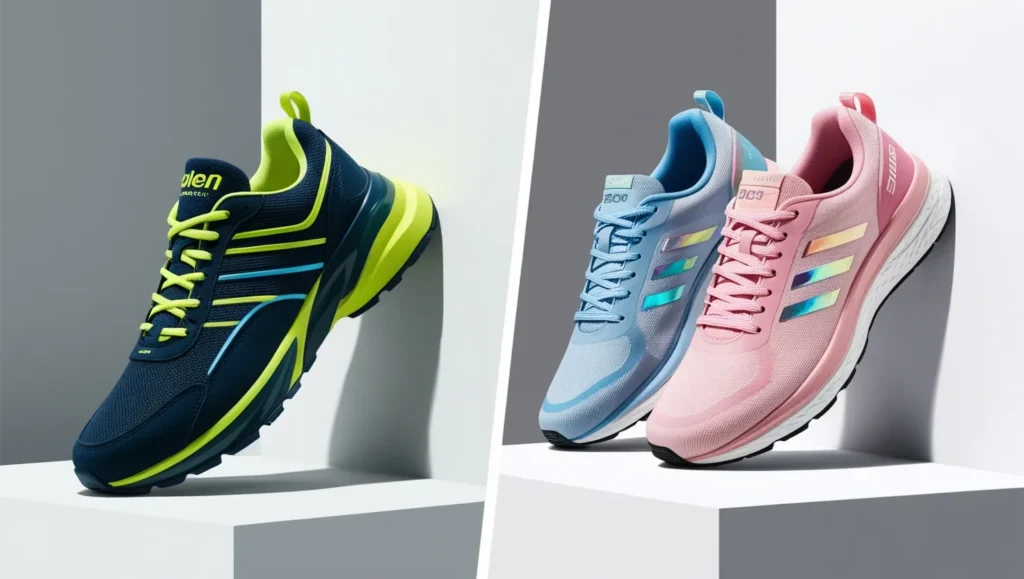
Running shoes are an essential investment for anyone aiming to stay fit, reduce injury risks, and enhance performance. However, many may not realize that men’s and women’s running shoes differ significantly in design, construction, and fit. These differences go beyond aesthetics, ensuring each gender gets the optimal support and comfort tailored to their unique physiological and biomechanical needs. Below, we delve deep into the key distinctions between men’s and women’s running shoes.
1. Anatomical Differences and Their Impact on Shoe Design
Shape and Width Variations
Men and women have different foot shapes. On average, women’s feet tend to be narrower in the heel and wider in the forefoot area, while men’s feet are broader overall. As a result:
- Men’s Running Shoes: Typically wider across the toe box and midfoot to accommodate broader feet.
- Women’s Running Shoes: Designed with a narrower heel cup to prevent slipping and a more spacious forefoot to ensure comfort.
Arch Support
Women’s arches tend to collapse more easily due to differences in ligament flexibility and foot structure. This has influenced how running shoes cater to arch support:
- Men’s Shoes: Provide standard arch support suitable for most male runners.
- Women’s Shoes: Often incorporate enhanced arch support or more cushioned midsoles to combat overpronation.
2. Weight and Cushioning Adjustments
Weight Distribution
On average, women weigh less than men of the same height. This difference directly impacts shoe cushioning:
- Men’s Running Shoes: Include firmer midsoles to support greater body weight and provide better durability.
- Women’s Running Shoes: Feature softer and lighter cushioning to accommodate reduced weight and improve responsiveness.
Foam Density
Running shoe manufacturers often use gender-specific foam densities. Women’s shoes might utilize less dense midsoles for added comfort and better shock absorption, ensuring a lighter, more natural stride.
3. Biomechanics: How Men and Women Run Differently
Gait Patterns
Studies reveal that women’s running mechanics differ from men’s due to wider hips and a higher Q-angle (the angle between the hip and knee). This leads to:
- Women’s Shoes: Designed to address inward rolling (overpronation) through features like dual-density midsoles or structured support.
- Men’s Shoes: Focus on providing neutral stability as men typically exhibit less pronounced pronation.
Stride Length
Women often have shorter strides and higher cadence than men. As a result:
- Women’s Shoes: Optimize flexibility and responsiveness to suit these unique motion patterns.
- Men’s Shoes: May prioritize rigidity and added stability for longer strides.
4. Heel-to-Toe Drop: A Key Differentiator
The heel-to-toe drop, or the difference in height between a shoe’s heel and forefoot, is often tailored for each gender:
- Men’s Shoes: Generally feature a slightly higher drop to support larger calf muscles and Achilles tendons.
- Women’s Shoes: Tend to have a lower drop, promoting a more natural footstrike for those with tighter calves and less flexibility.
5. Material and Construction
Upper Materials
The upper material of running shoes varies to ensure proper fit and comfort:
- Men’s Shoes: Built with denser materials for added durability, as men tend to exert greater force on their shoes.
- Women’s Shoes: Use lightweight, breathable fabrics to enhance comfort while reducing weight.
Outsole Design
The outsole—the bottom part of the shoe—also differs between genders:
- Men’s Shoes: Have thicker, more robust rubber outsoles to withstand higher impact forces.
- Women’s Shoes: Include more flexible and segmented outsoles to support smoother transitions and reduce fatigue.

6. Aesthetic Preferences
Though functionality reigns supreme, design differences also cater to consumer preferences:
- Men’s Running Shoes: Feature neutral or darker color schemes with minimal accents.
- Women’s Running Shoes: Often display brighter, more vibrant colors and sleeker silhouettes.
7. Sizing: Not Just About Length
Men’s and women’s running shoe sizes aren’t directly interchangeable:
- Men’s Sizes: Typically wider and longer, even at equivalent numerical sizes.
- Women’s Sizes: Proportionally adjusted to fit narrower feet. For instance, a woman’s size 9 generally equals a man’s size 7.
8. Importance of Gender-Specific Designs
Using the wrong type of running shoe can lead to discomfort, inefficient performance, and even injury:
- Men wearing women’s shoes: May experience insufficient width and stability, leading to foot strain.
- Women wearing men’s shoes: Risk heel slippage and inadequate support, resulting in overuse injuries.
To maximize comfort and performance, it’s crucial to choose gender-specific shoes designed to match your anatomy and biomechanics.
9. Should You Always Stick to Gendered Shoes?
While most runners benefit from gender-specific designs, exceptions exist. If you find a shoe from the opposite gender that fits better or meets your specific needs, don’t hesitate to consider it. Comfort and performance should always take precedence over labels.
Read Also: Trail vs. Road Running Shoes: Key Differences You Should Know
Conclusion
The differences between men’s and women’s running shoes go far beyond appearances. From anatomical and biomechanical variations to distinct cushioning and support requirements, these distinctions ensure that each gender receives footwear tailored to their unique needs. Selecting the right running shoe is not just about comfort—it’s about optimizing performance and minimizing injury risks.

Hello, I am Natasha Rose. I am the founder of the website Best Running Shoes. I am from California, USA. I am a professional shoe analyzer and an employee in a shoe showroom. I like to provide information about all types of shoes.






